SLO County programs can help save seniors from the streets — but more housing is still needed
The story was originally published in The Tribune with support from our 2024 California Health Equity Fellowship.
Editor’s Note: This is the third in a three-part series — Aging on the Streets — on senior homelessness in San Luis Obispo County.
Before Mark DenDekker’s life was hit by a series of “four torpedoes” over the past decade, life was moving along as planned for the Southern California native. But then, a divorce, a layoff and two costly injuries sent his life into a spiral that erased his nest egg and left him homeless in Atascadero at age 56 for the first time in his life.
DenDekker’s story is an all-too-familiar one for homeless service providers in San Luis Obispo County, who are tasked with helping people facing a wide range of personal challenges.
Depending on the person, that requires a multi-pronged approach combining housing support along with other assistance like food, transportation, health care and even basic socialization so that people don’t fall through the cracks to even worse outcomes.
It is that collection of efforts that can help curb senior homelessness, preferably before they end up on the streets.
“Why do bad things happen to good people?” DenDekker mused. “You think if you do all the right things, then all the right things are gonna happen, but really bad things happen to really good people — wrong place at the wrong time.”

Mark DenDekker has written an autobiography “A Boy’s Life Journey.” He was injured when he stepped on coral and developed an infection that nearly cost him his foot. Healthcare access remained and an issue for DenDekker, who was staying at the ECHO shelter in Atascadero on June 26, 2024.
David Middlecamp dmiddlecamp@thetribunenews.com
From college graduate to homeless senior
DenDekker, 61, grew up in Santa Monica and rode his golfing talents as one of the top junior golfers in the country to a scholarship at San Diego State University, where he majored in English.
He chased amateur and professional golfing ambitions through his 20s but was able to always provide for himself and his family by waiting tables — a job he came to realize he loved — for nearly 40 years. Life began to take a turn for the worse starting with a divorce that hurt him financially, but his situation took another big hit in 2009 when he lost his job to the Great Recession.
Then, in 2015, he tore his Achilles tendon, which made working on his feet impossible for nearly two years. His morale took a blow in 2017 when his mother passed away, though she did leave him enough money to restart his life in a new job in Hawaii in May 2018.
It didn’t last long, however. A week into his time in Hawaii, DenDekker suffered a foot injury that would change his life forever.
“What happened to me was 0% my fault — I just literally stepped in the wrong place,” DenDekker said. “I stepped on a piece of coral and I didn’t even know (my foot) was infected.” What followed was a 21-day stay in the hospital, during which DenDekker’s foot and ankle underwent eight separate surgeries to combat a case of necrotizing fasciitis — an aggressive strain of flesh-eating bacteria that nearly cost DenDekker his foot.
The injury left DenDekker unable to walk for more than four months, which sapped his funds, cost him his housing and has continued to hamper his mobility since then, keeping him out of the only field of work in which he had an established background.
In the three following years, DenDekker exhausted his remaining financial resources traveling between Maui and San Luis Obispo County for follow-up surgeries on his foot.
He thought San Luis Obispo County would be a good place to settle and recover while maintaining his California insurance.
“It was enough for me to survive, but the one thing I just couldn’t afford was rent,” DenDekker said.
DenDekker said he has no income or benefits of any kind and is currently in a disability case with Social Security, which he hopes will provide enough income to put a roof over his head.
He said he doesn’t qualify for many benefits besides CenCal, and isn’t actively pursuing more resources while he waits for his Social Security case to be resolved.
The only resources he consistently uses are the 40 Prado Homeless Services Center and the El Camino Homeless Organization’s shelter services, but never for a place to sleep at night.
So that leaves him on the streets.
“The shelter is not the answer,” DenDekker said. “They’re just putting Band-Aids on a gushing wound.”
Seniors fall through many cracks in social safety nets
Jerry Mihaic, community information coordinator for the Independent Living Resource Center, said his organization has seen a distinct increase in recent years in requests for services and resources that can alleviate day-to-day needs for older adults, along with more complex issues such as housing placement and social services.
Though the center serves people with a broad range of disabilities, Mihaic said an ever-increasing share of requests come from seniors, making up around 70% of all requests for services this year.
Overwhelmingly, those requests are for housing assistance and placement, with more older seniors requesting in-home support services such as mobility devices, personal assistance and in-home care, Mihaic said.
“They’re not saving money, and everything just continues to go up as well. It’s not just the rent itself — it’s all the utilities, the food, transportation, gas, all of that stuff,” Mihaic said. “It’s a very high cost-of-living area to live in.”
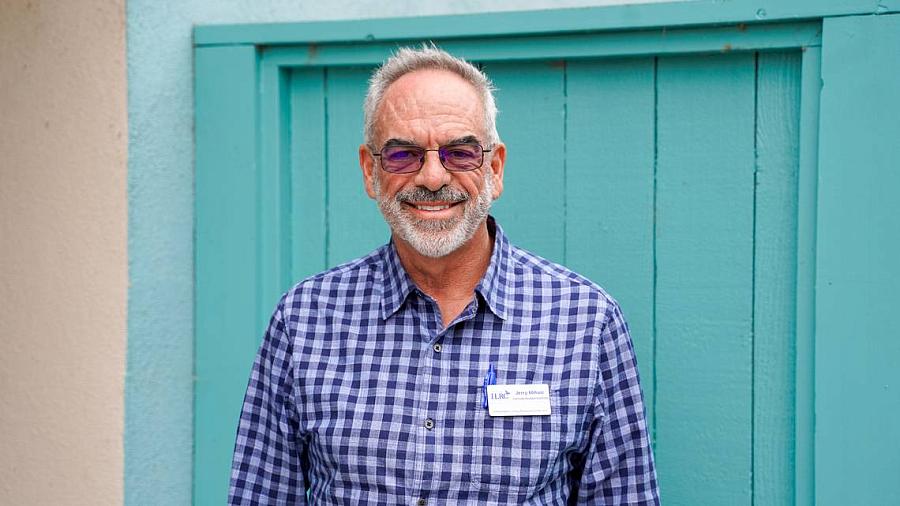
Jerry Mihaic is the community information coordinator of the Independent Living Resource Center in San Luis Obispo, pictured Wednesday, Sept. 25, 2024. Mihaic said more housing for seniors is needed San Luis Obispo County, with high demand forcing seniors to adapt their current homes for longer-term living.
Though seniors can seek out the center’s help for a variety of reasons, those struggling with the area’s high cost of living tend to not qualify for many housing and cost-of-living assistance programs, which often have narrow specifications for qualification.
The programs that seniors can qualify for often feature long waiting lists, which makes it important for older residents struggling with cost of living to take action early.
Mihaic said there’s also an education and awareness gap that results in many seniors being unsure of what benefits they could qualify for, which is where agencies such as the Independent Living Resource Center step in, helping to facilitate those connections.
With limited housing, seniors look to age in place longer
As the cost of living continues to rise each year in San Luis Obispo County, seniors are reevaluating where they might spend the remaining years of their lives.
Mihaic said more seniors are trying to age in place than ever before, prioritizing making their homes suitable through use of in-home care and relying on local programs that can fill in the gaps in their abilities.
That can include everything from food deliveries to fostering social connections so seniors don’t become isolated from their community.
But first, they need a living space that meets their needs.
Multiple residential home developers interviewed by The Tribune said that senior housing — be that independent living, assisted living, nursing or memory care — is a niche that many builders are unwilling to invest in.
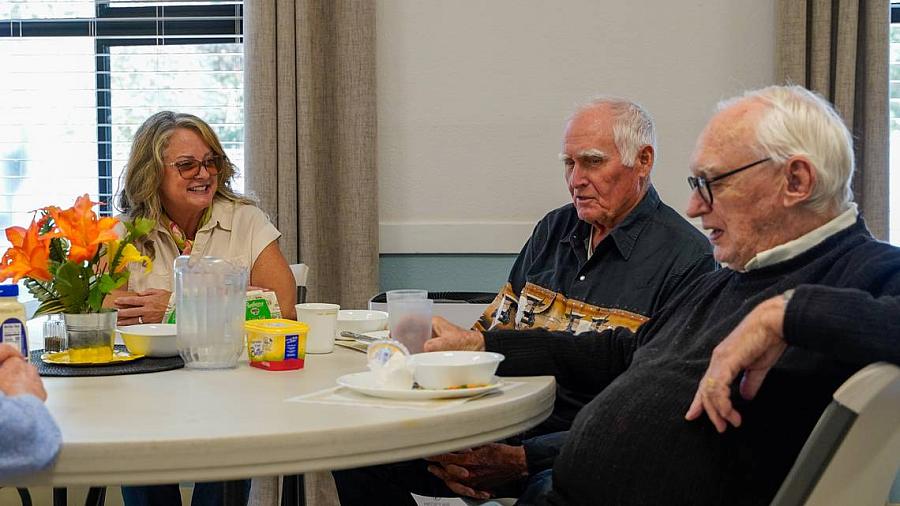
Meals that Connect executive director Laura Edwards and San Luis Obispo residents Lloyd Kattenhorn and Roy McGee enjoy a meal provided by Meals that Connect at United Church of Christ Tuesday, Sept. 24, 2024. Meals that Connect provides seniors with access to a free lunch every day at several San Luis Obispo County locations.
Max Zappas, CEO of Z Villages Management & Development, said development of senior housing is limited by the already-thin margins for home-building in California.
“Our company’s never done it — we’ve looked at senior housing properties before, but again, they just have a lot of challenges and we’re not as familiar with it,” Zappas said.
“As the boomers continue to age, that demand is going to continue to drive probably for the next 10, 15 years.” Aaryn Abbot, vice president of residential developer Abbott | Reed Inc., shared Zappas’ appraisal of the situation. He said in 2024, inflation has hurt the speed and risk tolerance of the construction industry, meaning securing the funds to get into an already-difficult niche has gotten harder.
“When I go to get a loan for a new project, not only are the rates more expensive — which makes it harder to pencil — the banks are less likely to lend it, but then on top of that, even if I get a bank on board and I’m able to secure the financing, the appraiser is going to come in,” Abbot said. “We’re at a time where appraisals are backward looking because they need comps, and so the comps are all not looking great at the worst part of the monetary cycle.“
The effects of that financial shortfall are evident in San Luis Obispo, where plans for a 400-unit senior independent and assisted living community known as Villaggio was scrapped in early 2024 after “numerous delays and obstacles” forced investors to ditch the project, according to Villaggio CEO Mark De Lotto.
While there’s still a chance the Villaggio project will return in a different form, it represents a significant setback for a project that was originally announced in 2017 and was supposed to break ground in 2020.
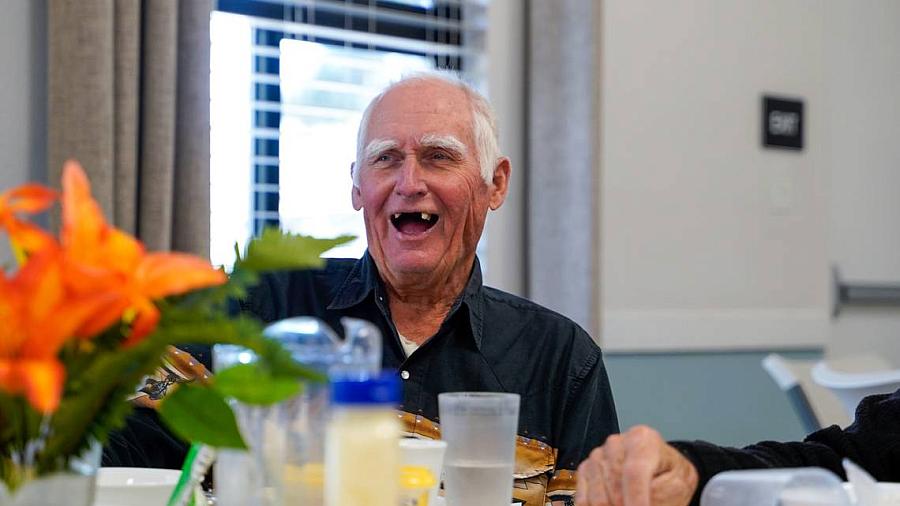
San Luis Obispo resident Lloyd Kattenhorn enjoys a meal provided by Meals that Connect at United Church of Christ Tuesday, Sept. 24, 2024. Meals that Connect provides seniors with access to a free lunch every day at several San Luis Obispo County locations.
Other services can help seniors stay in their homes
With seniors staying in their homes longer to avoid facing housing shortages and steep prices, more and more are turning to a patchwork of services that can meet their basic needs.
Laura Edwards, executive director of Meals that Connect, said her organization delivers meals to more than 2,000 clients in San Luis Obispo County every day, and has seen a “tremendous amount” of calls from seniors in the middle- or lower-income range.
Her service relies on more than 400 volunteers to deliver meals to seniors.It also hosts community dinners in nine different locations across the county.
“I think sometimes the socialization is even more important to them than the nutrition, honestly,” Edwards said. “Obviously, food is a high second, but they’re so hungry for both the food and the company.”
Lloyd Kattenhorn, a former resident of the Anderson Hotel’s affordable housing, said he attends Meals that Connect’s lunches regularly to save money and get a decent bite to eat.
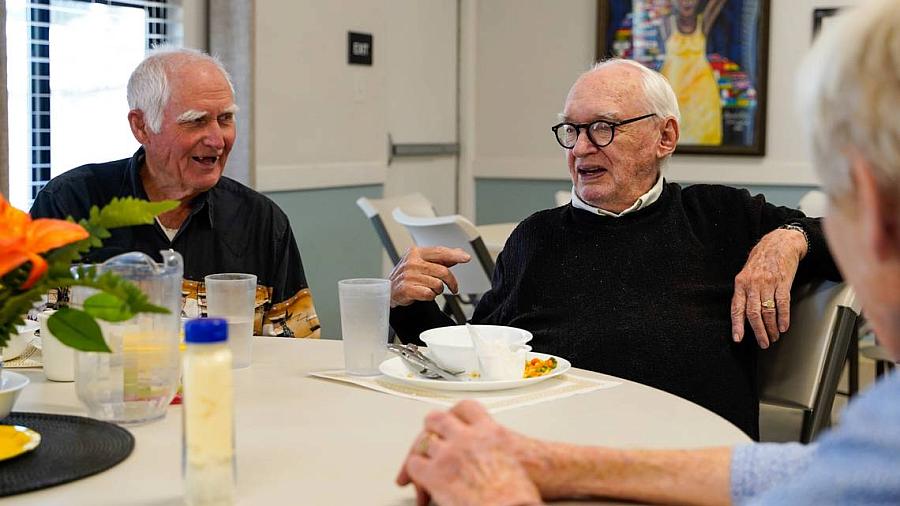
San Luis Obispo residents Lloyd Kattenhorn and Roy McGee enjoy a meal provided by Meals that Connect at United Church of Christ Tuesday, Sept. 24, 2024. Meals that Connect provides seniors with access to a free lunch every day at several San Luis Obispo County locations.
Joan Lynch jlynch@thetribunenews.com
Kattenhorn said he used to receive food delivery services from Meals on Wheels when he lived at the Anderson, and said he misses the community meals that staff at the Anderson used to host around the holidays. Now, he attends lunches through Meals that Connect as much for the company as the food, he said.
“It’s a good, balanced meal, and you don’t have to cook it,” Kattenhorn said. “It probably contributes to my health — at this age, you have to get a balanced diet.”
Edwards said many of the seniors who attend her organization’s meals won’t consider moving into assisted living due to the price alone. As the population continues to increase in age on average, extending the amount of time a senior with housing can keep a relatively affordable roof over their head will only get more important.
Seniors Helping Seniors is one such private nonprofit that aims to keep seniors housed with the services they need as long as possible by hiring older adults to care for other senior residents.
Maryanne Zaryca, training and care director at Seniors Helping Seniors, said while her program does have a cost, it’s far less than most senior-specific housing, making it more appealing to seniors with less money on hand.
Employing caregivers closer to the age of the clients they’re serving also makes it easier to connect with seniors, and can make them more receptive to exploring other programs that can extend their quality of life at home, Zaryca said.
“They understand what it feels like getting older and not being able to do the things that we can do anymore, so they can have a little extra compassion for the elders that they’re taking care of,” Zaryca said.
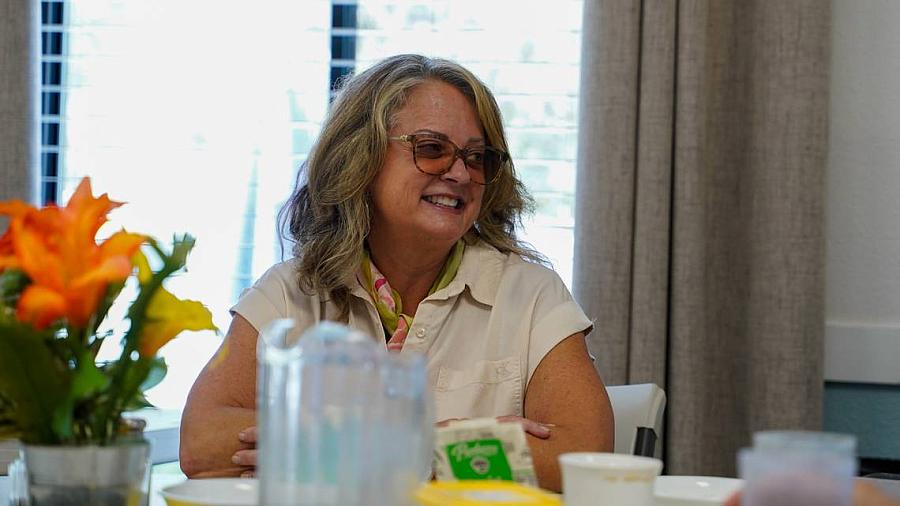
Meals that Connect executive director Laura Edwards attends a meal provided by Meals that Connect at United Church of Christ Tuesday, Sept. 24, 2024. Meals that Connect provides seniors with access to a free lunch every day at several San Luis Obispo County locations.
SLO County needs more senior housing
Given the size of San Luis Obispo County’s over-55 population — an estimated 99,000 compared to a population of 282,000, according to U.S. Census estimates — Gibson said she’s surprised more “big box” older living communities and care ventures haven’t sprung up to meet the obvious demand.
For costs to come down enough for most San Luis Obispo County seniors to have a shot, Gibson said the county needs to see a 50% increase in overall bed capacity — 50% more memory care beds, 25% more assisted living beds and 25% more independent living beds.
Darlene Maphis has lived in San Luis Obispo County since 2020 and has faced homelessness and the weight of high cost of living since returning.
Maphis, 66, had been living in Arizona for more than two decades, but when her husband died, she returned to the region where she was born to live with her son and be close to her grandchildren.
A falling out with her son in 2021 led her to seek housing through ECHO’s shelter in Atascadero, where she stayed for a little over a year while she worked to get her life and health back on track, she said.
When she first sought shelter at ECHO, Maphis was suffering from internal bleeding and several chronic behavioral and health conditions that made it impossible to work, including stage 3 kidney disease, short-term memory loss from dementia and sciatica from a back injury that limits her mobility.

Darlene Maphis, 66, stands with her wheelchair in her apartment at the Templeton Place II affordable housing community on Thursday, Sept. 19, 2024. Maphis said even with affordable housing and some of her expenses covered, she still struggles with San Luis Obispo County’s high cost of living.
John Lynch jlynch@thetribunenews.com
But by proactively doing “the homework” and working with ECHO case managers, Maphis was eventually placed in affordable housing in Templeton that suits her needs.
Her unit at People’s Self-Help Housing’s Templeton II complex is disability-friendly and affordable, but there are still challenges that go unanswered.
Though her unit costs no more than 30% of her income — mostly Social Security Disability Insurance — other costs can still be out of reach, she said.
Dental care is one of her biggest needs, she said.
With no insurance to pay for dentures and upkeep, Maphis’ diet consists mostly of softer foods, which can present challenges when her options are limited by cost and what the SLO Food Bank delivers each week.
Maphis’ apartment also is not equipped with a bathtub, which she said is the best way to clean herself, and between high costs and low availability, she’s been unable to find a consistent caregiver who can help with cooking, cleaning and getting access to resources.
“They need to buckle down and get some fundraising for caregiving,” Maphis said. “Caregivers are in great demand here.”
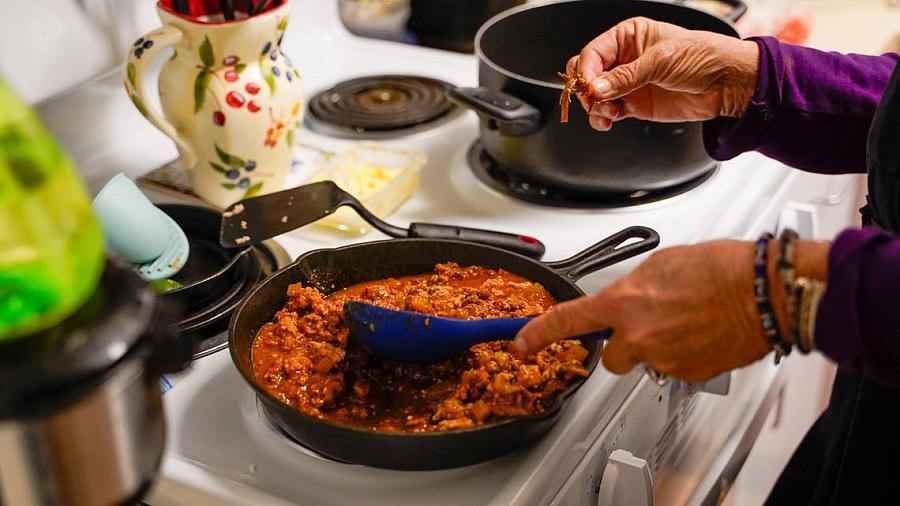
Darlene Maphis, 66, prepares a meal in her apartment at the Templeton Place II affordable housing community on Thursday, Sept. 19, 2024. Maphis said even with affordable housing and some of her expenses covered, she still struggles with San Luis Obispo County’s high cost of living.
John Lynch jlynch@thetribunenews.com
Though Maphis’ rent was recently lowered slightly by an adjustment from People’s Self-Help Housing, her CalFresh benefits were reduced as a result, from around $114 to just $62 per month, she said.
The CalFresh benefit would go further if her dementia didn’t make reporting her food and gas expenses more difficult, she said. She’s been able to patchwork together a series of benefits and discounts to make everything pencil out, but she’s still left with little money to save each month for a rainy day, Maphis said.
“What kills all of us seniors is the water and electricity that we’re paying,” Maphis said. “If it wasn’t for (my case worker) knowing some people and agencies to help ... I wouldn’t have gotten help with those bills . I’d still be stuck or my power would be off.”
Mihaic said if most low-income seniors are going to have any shot at living comfortably and independently in this county, the state and local governments will need to look at introducing more subsidies for utilities, maintenance and housing.
He also said rent control would be a surefire way to keep prices affordable for seniors, whose fixed incomes will only continue to be surpassed by inflation.
It also would help stanch the bleeding of low-income seniors into the homeless population, as most service providers agree that it is far more cost-effective to prevent homelessness than it is to get a homeless person back into housing.

Darlene Maphis, 66, prepares a meal in her apartment at the Templeton Place II affordable housing community on Thursday, Sept. 19, 2024. Maphis said even with affordable housing and some of her expenses covered, she still struggles with San Luis Obispo County’s high cost of living.
John Lynch jlynch@thetribunenews.com
Reaching out to seniors to learn their needs
To help fully understand the breadth of the problem, Linda Belch, deputy director of Adult Protective Services and the county’s homeless services division, said San Luis Obispo County is actively seeking feedback from senior residents through focus groups that will guide efforts to conform with California’s Master Plan for Aging.
That master plan is a 10-year blueprint for improving California’s ability to support its population at all age levels, but is still in the early stages of implementation.
There’s also hope that California’s Assisted Living Waiver Program — a pilot program that allows individuals to use Medi-Cal to pay for assisted and subsidized housing — will reach San Luis Obispo County in the coming years, potentially making more of the county’s beds affordable to seniors and people with disabilities, Belch said.
The program is only active in 15 counties so far and has yet to reach the Central Coast, but Belch said the county will need to build more units to accommodate potential users of the Assisted Living Waiver Program ahead of its introduction.
“We are definitely needing to expand capacity, but do you expand capacity before you have the ability to fill those beds?” Belch said. “It’s a chicken and egg question.”
Until then, Belch said increasing the number of housing navigators who can pair seniors with potential housing would be helpful, along with making more Section 8 Housing Choice Vouchers available.
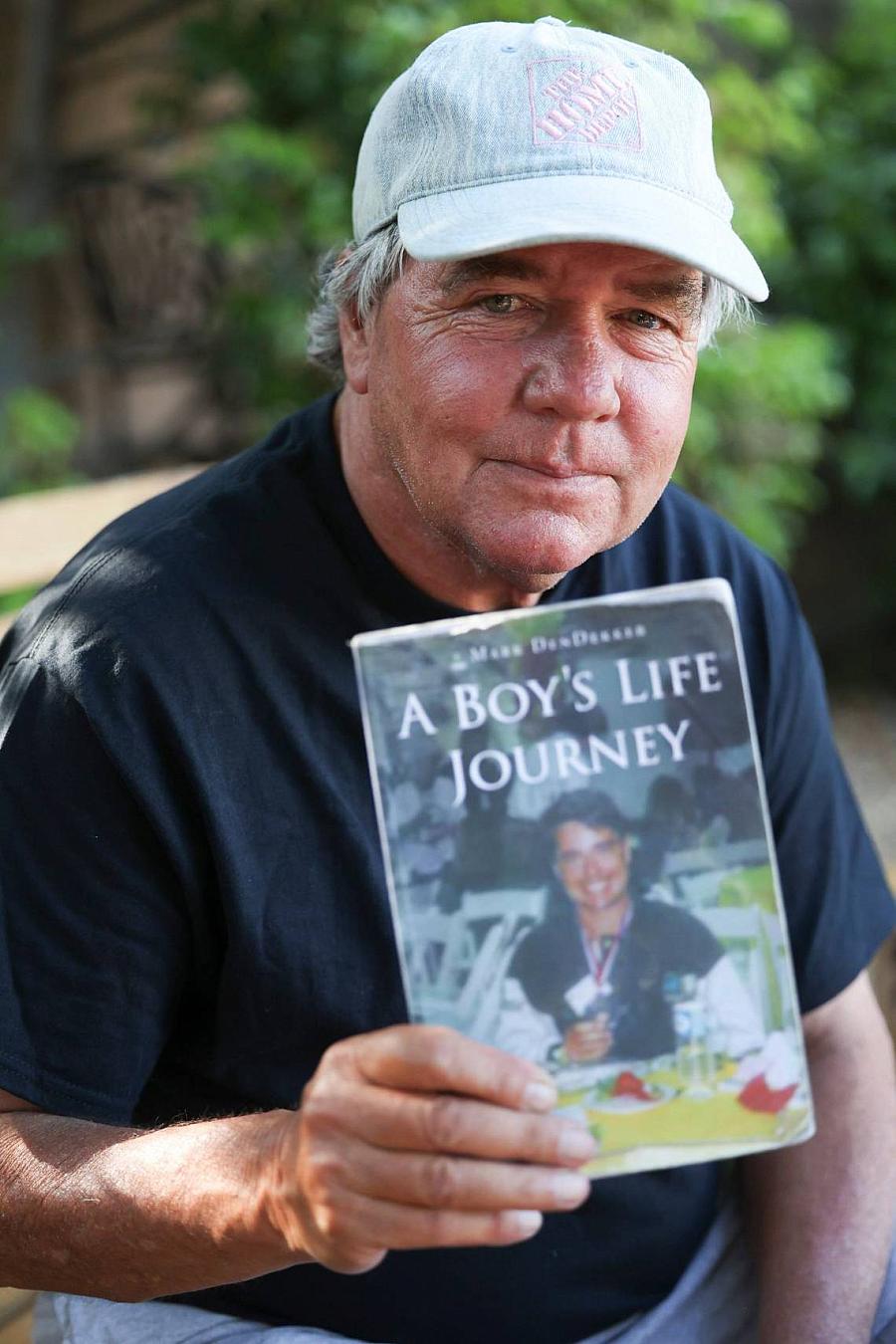
Mark DenDekker has written an autobiography “A Boy’s Life Journey.” He was injured when he stepped on coral and developed an infection that nearly cost him his foot. Healthcare access remained and an issue for DenDekker, who was staying at the ECHO shelter in Atascadero on June 26, 2024.
David Middlecamp dmiddlecamp@thetribunenews.com
Like so many other San Luis Obispo County seniors, Mark DenDekker is still waiting for his chance to find a home that fits his price and health needs. While homeless and recovering from his injury, DenDekker put his life experience on paper, rediscovering the passion for writing that first emerged while he was still on a golf scholarship.
“My resume used to be restaurant, restaurant, restaurant — I can’t do that anymore,” DenDekker said. “I’ve got a new resume that has an English degree on it, and I’m a published New York author.
That’s gotta count for something.” DenDekker compiled his life story from early years through his struggle with health and homelessness in his book, “A Boy’s Life Journey,” publishing the memoir through Newman Springs in 2023.
He said while he waits — for health appointments, housing and other types of aid — he’ll continue plugging away at a sequel that follows his journey of survival through homelessness.
“The last thing I said in the book besides the author’s note stuff was that this book is not yet finished,” DenDekker said. “This boy’s journey is not done yet, and that’s why I kind of think that I need to write about the homeless period of time as well — whether good, bad or different, it was part of the whole journey.”

